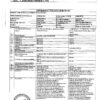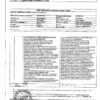No products in the cart.
Maxigan, tablets 20 pcs
€9.90 €8.25
Description
The composition of the drug includes: non-narcotic analgesic sodium metamizole myotropic antispasmodic agent pitophenone hydrochloride and m-cholinergic agent fenpiperinia bromide.
Sodium metamizole is a derivative of pyrazolone. It has analgesic antipyretic and anti-inflammatory effects.
Pitophenone hydrochloride, like papaverine, has a direct myotropic effect on the smooth muscles of internal organs and causes them to relax.
Phenpiperinia bromide has an additional relaxing effect on the smooth muscles due to its m-cholinoblocking action.
The combination of the three components of the drug leads to pain relief and relaxation of smooth muscles and reduction of elevated body temperature.
Pharmacokinetics:
Sodium metamizole is hydrolyzed in the intestinal wall to form the active metabolite – there is no unchanged sodium metamizole in blood (only after IV administration a small concentration is found in plasma). Binding of the active metabolite with proteins is 50-60%. It is metabolized in the liver and excreted by the kidneys. In therapeutic doses penetrates into breast milk.
After administration of pitophenone hydrochloride is excreted in the urine. The elimination half-life is 18 hours.
Phenpiperinia bromide is excreted by the kidneys 324 – 404 % in unchanged form with bile 25 – 53 % of the substance is excreted.
Indications
Indications
Mild to moderate pain syndrome with spasms of the smooth muscles of internal organs – renal and hepatic colic, pain of a spastic character along the intestine, algodysmenorrhea.
May be used for short-term symptomatic treatment of joint pain, neuralgia, ischialgia, myalgia.
As an adjuvant it can be used to reduce pain after surgical and diagnostic interventions. If necessary, the drug may be used for decreasing the body temperature during cold and infectious-inflammatory diseases.
Active ingredient
Active ingredient
How to take, the dosage
How to take, the dosage
Adults and children over 15 years of age use orally (preferably after meals) usually ‘1-2 tablets 2-3 times a day, without chewing, with a small amount of liquid. Daily dose should not exceed 6 tablets.
The duration of use is not more than 5 days.
Lengthening the daily dose of the drug or the duration of treatment is possible only with the recommendation and under the supervision of a physician.
Dosages for children.
In children, the drug is used only by prescription.
Children 12-14 years old: a single dose – 1 tablet, the maximum daily dose – 6 tablets (1.5 tablets 4 times a day), 8-11 years old – 0.5 tablets, the maximum daily dose – 4 tablets (1 tablet 4 times a day), 5-7 years old – 0.5 tablets, the maximum daily dose – 2 tablets (0.5 tablets 4 times a day).
Interaction
Interaction
When co-administered with H1-histaminoblockers, butyrophenones, phenothiazines, tricyclic antidepressants, amantadine and quinidine the m-cholinoblock action may be increased.
It enhances the effects of ethanol: simultaneous use with chlorpromazine or other phenothiazine derivatives may lead to significant hyperthermia.
Tricyclic antidepressants, oral contraceptives and allopurinol increase the toxicity of the drug.
Phenylbutazone, barbiturates and other hepatoinducers decrease the effectiveness of sodium metamizole when administered simultaneously. Sedatives and anxiolytics (tranquilizers) increase the analgesic effect of sodium metamizole.
The radiographic contrast drugs, colloidal blood substitutes and penicillin should not be used during treatment with drugs containing sodium metamizole.
The concomitant administration of cyclosporine decreases the concentration of the latter in blood. Sodium metamizole displaces oral hypoglycemic drugs, indirect anticoagulants, GCS and indomethacin from protein binding and may increase the severity of their effects. Thiamazole and cytostatics increase the risk of leukopenia.
The effect is increased by codeine, H2-histamine receptor blockers and propranololol (inhibits inactivation of sodium metamizole).
Special Instructions
Special Instructions
It is not recommended to take ethanol during treatment with the drug. During long-term (more than one week) treatment it is necessary to monitor peripheral blood count and liver function status. If agranulocytosis is suspected or in the presence of thrombocytopenia, the drug should be discontinued. It is unacceptable to use to relieve acute abdominal pain (until the cause is clarified). Use in breastfeeding mothers requires discontinuation of breastfeeding.
Intolerance is very rare, but the risk of anaphylactic shock after IV administration is relatively higher than after oral administration. Patients with atopic bronchial asthma and pollinosis have an increased risk of allergic reactions.
Parenteral administration should only be used when oral administration is not possible (or absorption from the gastrointestinal tract is impaired). Particular caution is required when administering more than 2 ml of the solution (risk of rapid drop in blood pressure). The intravenous injection should be performed slowly in the “lying” position and under control of blood pressure, heart rate and respiratory rate.
When treating children under 5 years of age and patients receiving cytostatic drugs the administration of sodium metamizole should be carried out only under medical supervision. For intravenous administration a long needle must be used.
The urine may turn red due to metabolite excretion (of no clinical significance).
We should use caution during treatment for drivers of vehicles and people engaged in potentially hazardous activities requiring quick physical and mental reactions.
Contraindications
Contraindications
Hypersensitivity to pyrazolone derivatives and other components of the drug. Inhibition of medullary hematopoiesis, stable and unstable angina pectoris, decompensated chronic heart failure, hepatic and/or renal failure; glucose-6-phosphate dehydrogenase deficiency; tachyarrhythmia; closed-angle glaucoma; Prostate hyperplasia with a tendency to urinary retention; intestinal obstruction and megacolon; bronchial asthma, urticaria, or acute rhinitis provoked by taking acetylsalicylic acid, salicylates and other nonsteroidal anti-inflammatory drugs; granulocytopenia; pregnancy; lactation.
Maxigan® in this dosage form is not recommended for use in children under 5 years of age.
The drug should be used with caution and under medical supervision in patients with impaired hepatic or renal function, if there is a tendency to arterial hypotension (systolic blood pressure less than 100 mm Hg), bronchospasm. In impaired hematopoiesis as a result of treatment with cytostatics.
If you have any of the conditions listed above, be sure to talk to your doctor before taking this medication.
Side effects
Side effects
The frequency. of adverse reactions listed below was determined according to the following (World Health Organization classification): very common – more than 1/10; common – more than 1/100 to less than 1/10; infrequent – more than 1/1000 to less than 1/100; rare – more than 1/10000 to less than 1/1000; very rare – less than 1/10000, including individual reports.
Allergic reactions: urticaria, angioedema, in rare cases – erythema malignant exudative (Stevens-Johnson syndrome), toxic epidermal necrolysis (Lyell’s syndrome), bronchospastic syndrome, anaphylactic shock. Urinary system disorders: impaired renal function, oliguria, anuria, proteinuria, interstitial nephritis, staining of urine red.
Cardiovascular system: decreased blood pressure.
Hematopoietic disorders: thrombocytopenia, leukopenia, agranulocytosis (may be manifested by the following symptoms: unexplained fever, chills, sore throat, difficulty in swallowing, stomatitis, and development of vaginitis or proctitis).
Anticholinergic effects: dry mouth, decreased sweating, paresis of accommodation, tachycardia, difficult urination.
If you experience any adverse side effects, see your doctor as soon as possible.
If any of the side effects mentioned in the instructions worsen, or if you notice any other side effects not mentioned in the instructions, tell your doctor.
Overdose
Overdose
Symptoms: vomiting decreased blood pressure drowsiness confusion nausea epigastric pain liver and kidney malfunction seizures.
Treatment: symptomatic therapy.
Similarities
Similarities
Additional information
| Weight | 0.022 kg |
|---|---|
| Shelf life | 3 years |
| Conditions of storage | In a dry, light-protected place at 0-25 °C |
| Manufacturer | Unichem Laboratories Ltd, India |
| Medication form | pills |
| Brand | Unichem Laboratories Ltd |
Related products
Buy Maxigan, tablets 20 pcs with delivery to USA, UK, Europe and over 120 other countries.





















